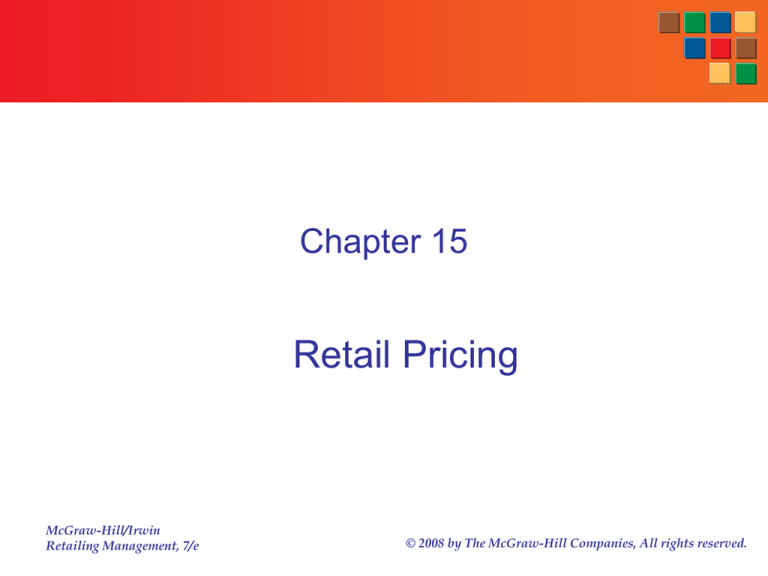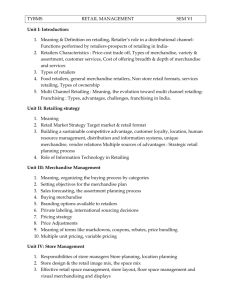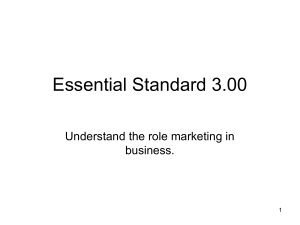
Chapter 15
Retail Pricing
McGraw-Hill/Irwin
Retailing Management, 7/e
© 2008 by The McGraw-Hill Companies, All rights reserved.
Merchandise Management
Managing
Merchandise
Assortments
Chapter 12
Buying
Merchandise
Chapter 14
Retail
Pricing
Chapter 15
Merchandise
Planning
Systems
Chapter 13
Retail
Communication
Mix
Chapter 16
15-2
Questions
■ What factors do retailers consider when pricing
merchandise?
■ What are the legal restrictions on retail pricing?
■ How do retailers set retail prices?
■ How do retailers make adjustments to prices over time
and for different market segments?
■ Why do some retailers have frequent sales while others
attempt to maintain an everyday-low-price strategy?
■ What pricing tactics do retailers use to influence
consumer purchases?
15-3
Why is Pricing Important?
■ Pricing decision is important because customers have
alternatives to choose from and are better informed
■ Customers are in a position to seek good value
Value = perceived benefits
price
■ So, retailers can increase value and stimulate sales by
increasing benefits or reducing price.
15-4
Retailers Use Private Label Products to
Increase Value
15-5
Considerations in Setting Retail Prices
15-6
Customer Price sensitivity and Cost
Relationship between Price Sensitivity and Demand
When
price
increases
sales can decrease
as fewer customers feel the product is a good value
15-7
Price Experiment
An approach used to measure the price sensitivity of customers
Number of movie tickets sold at difference prices
Results of Price Experiments
15-8
Price sensitivity of customers
(demand curve)
Quantity Sold at Different Prices
If customers are very price sensitive,
Sales decrease significantly
with price increase
15-9
Profit at Different Prices
15-10
Price Elasticity
A commonly used measure of price sensitivity
Elasticity = percent change in quantity sold
percent change in price
15-11
Price Elasticity
■ Assume that a retailer originally priced a privatelabel DVD play at $90 and raised the price to
$100. Prior to raising the price, the retailer was
selling 1,500 units a week. When the price was
increased, sales dropped to 1,100 units per
week. What is the price elasticity of the product?
15-12
Price Elasticity
Elasticity = percent change in quantity sold
percent change in price
= (new quantity sold – old quantity sold)/old quantity sold
(new price – old price)/(old price)
= (1100-1500)/1500
(100-90)/90
= -0.2667
.1111
= -2.4005
Price elasticity is a negative number because the quantity sold usually
Decreases when prices increase. When price elasticity is greater than - 1,
the target market for a product is viewed to be price insensitive
15-13
Price Elasticity by Product Type
Price Elasticity
Price Elasticity
■ Substitutable products/services
■ Products/services necessitates
■ Products that are expensive
relative to a consumer’s income
Historically, the price elasticity of gasoline has been greater than -1,
so increases in price have not led to a proportional decrease in sales.
15-14
Price Elasticity
For products with price elasticity less than -1, the price that maximizes
profits can be determined by the following formula:
Profit maximizing price = price elasticity x cost
price elasticity +1
15-15
Profit-Maximizing Price
in Relation to Price Elasticity
If the private-label DVD player costs $50, the
profit-maximizing price would be $85.70
Profit maximizing price = price elasticity x cost
price elasticity +1
= -2.4005 x $50
-2.4005 +1
= $85.70
15-16
Collecting and Using Competitive Price
Data
Most retailers routinely collect price data about their
competitors to adjust their prices to remain competitive
15-17
How Can Retailers Reduce Price Competition?
■ Develop lines of private
label merchandise
■ Negotiate with national
brands manufacturers for
exclusive distribution rights
■ Have vendors make
unique products for the
retailer
15-18
PhotoLink/Getty Images
Legal and Ethical Pricing Issues
■
■
■
■
■
■
Price Discrimination
Predatory Pricing
Resale Price Maintenance
Horizontal Price fixing
Bait and Switch tactics
Scanned vs. Posted Prices
PhotoDisc/Getty Images
15-19
Should bars be allowed
to have “ladies’ night”
when women are
admitted either for free
or at a reduced rate
and, once inside,
served drinks at
reduced prices? Is this
illegal price
discrimination?
15-20
Setting Retail Prices
How Do Retailers Set Retail Prices?
Theoretically, retailers maximize their profits by setting
prices based on the price sensitivity of customers and
the cost of merchandise and considering the prices
being charged by competitors.
In reality, Retailers need to set price for over 50,000 SKUs
many times during year
■ Set prices based on pre-determined markup and
merchandise cost
■ Make adjustments to markup price based on customer
price sensitivity and competition
15-21
Retail Price and Markup (MU)
Retail Price
$125
Margin
$50
Markup as a Percent
of Retail Price
40% = $50/$125
Cost of
Merchandise
$75
Retail Price = cost + markup
MU% = retail price – cost
retail price
15-22
Retail Price
Retail price = Cost of merchandise + Markup
Retail price = Cost of merchandise + Retail price x Markup %
Retail price =
Cost of merchandise
1 – Markup % (as a fraction)
15-23
Markups
Initial markup – retail selling price initially
set for the merchandise minus the cost
of the merchandise.
Maintained markup – the
actual sales realized for the
merchandise minus its costs
Rob Melnychuk/Getty Images
15-24
Initial and Maintained Markup
Reductions
$.10
Maintained
Markup
$.30
Maintained Markup as a
Percent of Actual Sales
33% = $.30/$.90
Initial Retail
Price $1.00
Cost of
Merchandise
$.60
15-25
Initial markup
100%
+
Initial markup % =
Reductions %
Maintained markup %
(as a percent of planned + (as a percent of planned
actual sales)
actual sales)
Reductions %
(as a percent of planned
actual sales)
15-26
Initial Markup and Initial Retail Price
Merchandise costs $.60. If the buyer planned on reductions of 10%
of sales and wanted a maintained markup of 33% for the
merchandise ,
Initial markup % =
Initial retail price =
33% + ($0.10/$0.90 = 11.11%)
100% + 11.11%
Cost
1 – Initial markup %
=
=
$0.60 =
1 – 0.40
40%
$1.00
15-27
Merchandising Optimization Software
■ Setting prices by simply marking up merchandise cost
neglect other factors (e.g., price sensitivity, competition,
the sales of complementary products)
■ Merchandising Optimization Software
Utilize a set of algorithms that analyzes past and
current merchandise sales prices
Estimates the relationship between prices and sales
generated
Determines the optimal (most profitable) initial price
for the merchandise and size and timing for
markdowns
15-28
Profit Impact of Setting a Retail Price:
The Use of Break-Even Analysis
■ A retailer might want to know
Break-even sales to generate a target profit
Break-even volume and dollars to justify introducing a new
product, product line, or department
Break-even sales change needed to cover a price change
■ Break-even analysis
Determines, on the basis of a consideration of fixed and variable
costs, how much merchandise needs to be sold to achieve a
break-even (zero) profit
Fixed costs: don’t change with the quantity of product produced
and sold
Variable costs: vary directly with the quantity of product produced
and sold (e.g., direct labor and materials used in producing a
product)
15-29
Breakeven Analysis
Understanding the Implication of Fixed and Variable Cost
Contribution/Unit
Breakeven
point
Fixed Costs
Unit Sales
Break-even
quantity
=
Fixed cost
Actual unit sales price - Unit variable cost
The quantity at which total revenue equals total cost, and then profit
Occurs for additional sales
15-30
Illustration of Breakeven Analysis:
Break-even volume of a new private-label product
PETsMART is interested in developing private label, dry
dog food targeting owners of older dogs that will sell for
$12 a bag. The cost of developing the dog food is
$700,000. This includes salaries for the design team
and testing the product. The variable cost of purchasing
the product from a private-label manufacturer is $5.
How many cargo pants does American Eagle Outfitter
have to sell to breakeven on its $400,000 investment?
15-31
Illustration of Breakeven Analysis:
Break-even volume of a new private-label product
Fixed cost
Actual unit sales price – Unit variable cost
Break-even quantity =
$700,000
$12 – $5
=
Now assume that PETsMART wants to make $100,000 profit from it
=
$700,000 + $100,000
$12 – $5
=
114,286 bags
15-32
Illustration of Breakeven Analysis:
Break-even Sales of a new private-label product
Now PETsMART is considering lowering the price to $10 with the same
profit goal. How many units does PETsMART need sell then to make
the same profit from the price cut?
Fixed cost
Break-even quantity =
Actual unit sales price – Unit variable cost
= $700,000 + $100,000
$10 – $5
=
160,000 bags
Unit sales must increase by 40%
15-33
Maximize Profits through
Price Discrimination
Want Charge Every Customer the Maximum
They Are Willing to Pay
Problem
Don’t know willingness to pay
With list prices, can’t prevent high willingness to
pay customers from buying at low price
15-34
Price Adjustments
Retailers adjust prices over time (markdowns) and
for different customer segments (variable
pricing)
■ Why do retailers take markdowns?
■ How do they optimize markdown decisions?
■ How do they reduce the amount of markdowns by
working with vendors?
■ How do they liquidate markdown merchandise?
■ What are the mechanics of taking markdowns?
15-35
Reasons for Taking Markdowns
■ Clearance Markdowns to get
rid of slow-moving, obsolete
merchandise
■ Promotional Markdowns
To increase sales and promote
merchandise
To Increase traffic flow and sale
of complementary products
generate excitement through a
sale
■ To generate cash to buy
additional merchandise
15-36
Optimizing Markdown Decisions
■ Traditional Approach- Use a set of arbitrary rules
Sell-Through: Identifies markdown items when its
weekly sell-through percentages fall below a certain
level
Rule-based: Cuts prices on the basis of how long the
merchandise has been in the store
■ Markdown Optimization
Software is used to determine when and how much
markdowns should be taken to produce the best
results by continually updating pricing forecasts on
the basis of actual sales and factoring in differences
in price sensitivities
15-37
Markdown Optimization Software
ProfitLogic
15-38
Liquidating Markdown Merchandise
Sell the merchandise to another retailer
Consolidate the unsold merchandise
Place merchandise on Internet auction site
Donate merchandise to charity
Carry the merchandise over to the next season
PhotoLink/Getty Images
■
■
■
■
■
15-39
Variable Pricing and Price Discrimination
Retailers use a variety of techniques to maximize profits by
charging different prices to different customers
■ Individualized Variable Pricing (First Degree of Price
Discrimination) – Set unique price for each customer
equal to customer’s willingness to pay
Auctions, Personalized Internet Prices
■ Self-Selected Variable Pricing (Second Degree of Price
Discrimination) – Offer the same price schedule to all
customers
Quantity discounts
Early Bird Special
Over Weekend Travel Discount
15-40
Shoppers at Ukrop’s use their loyalty card at
a kiosk and receive unadvertised
personalized coupons
eBay: Auction on
porsche speeder 1960
15-41
Variable Pricing and Price Discrimination
Continued
■ Clearance Markdowns for Fashion Merchandise
■ Coupons
■ Price Bundling
McDonald’s Value Meal
■ Multiple-Unit Pricing or Quantity Discount
■ Variable Pricing by Market Segments (Third Degree of
Price Discrimination) – Charge different groups different
prices
Seniors Discounts
Kids Menu
■ Zone Pricing (Third Degree of Price Discrimination) –
Charge different prices in different stores, markets,
regions
15-42
Solution to Problems in
Implementing Price Discrimination
■ Set prices based on customer
characteristics related to willingness
to pay
■ Fashion sensitive customers will pay
more so charge higher prices when
fashion first introduced – reduce price
later in season
■ Price sensitive customers will expend
effort to get lower prices – coupons
■ Elderly customers eat earlier and are
more price sensitive so offer early
bird specials
C. Borland/PhotoLink/Getty Images
15-43
Pricing Strategies: High/Low Pricing
Discount the initial prices through frequent sales
promotions
■ Advantages
Increases profits through price discrimination
Sales create excitement
Sells merchandise
■ Disadvantages
Train people to buy on deal and wait
Have an adverse effect on profits
15-44
Pricing Strategies: Everyday Low Pricing
■ Emphasizes the continuity of retail prices at a level
somewhere between the regular none-sale price and the
deep-discount sale price of high/low retailers
■ Doesn’t mean lowest price
■ Retailers have adopted a low price guarantee policy to
reinforce their EDLP strategy
■ Advantages:
Assures customers of low prices
Reduces advertising and operating expenses
Reduces stockouts and improves inventory management
15-45
Pricing Strategies
EDLP
■ Assures customers low
prices
■ Reduces advertising and
operating expenses
■ Better supply chain
management
Hi-Lo
■ Higher profits through
price discrimination
■ More excitement
■ Build short-term sales
and generates traffic
Fewer stockouts
Higher inventory turns
15-46
Pricing Services
Challenges due to
■ The need to match supply and demand
■ The difficulties customers have in determining
service quality
15-47
Matching Supply and Demand for Services
“Services are intangible and thus cannot be stocked”
Airline tickets Theater tickets, Concert tickets
“Services have capacity constraints”
Restaurants, Hotels, Flights, Concerts
Seats for some Hannah Montana concerts
go for $237 on StubHub, when the face
value for the ticket is $63
Yield Management:
The practice of adjusting prices up or down in response to
demand to control the sales generated
15-48
Determining Service Quality
Customers are likely to use price as an indicator of both service
costs and service quality This can depend on several factors:
Other information available to the
customer (Cues > Price)
•When service cues to quality are
readily accessible
•When brand names provide
evidence of a company’s
reputation
•When the level of advertising
communicates the company’s
belief in the brand
The risk associated with the service
purchase (Price as a surrogate for
quality)
Royalty-Free/CORBIS
15-49
Pricing Techniques for Increasing Sales
■ Leader Pricing
■ Price Lining
■ Odd Pricing
15-50
Leader Pricing
■ Certain items are priced lower than normal to increase
customers traffic flow and/or boost sales of
complementary products
■ Best items: purchased frequently, primarily by pricesensitive shoppers
■ Examples: bread, eggs, milk, disposable diapers
■ Might attract cherry pickers
Dennis Gray/Cole Group/Getty Images
Allan Rosenberg/Cole Group/Getty Images
Ryan McVay/Getty Images
15-51
Price Lining
■ A limited number of predetermined price points.
■ Ex: $59.99 (good), $89.99 (better), and 129.99
(best)
■ Benefits:
Eliminates confusion of many prices
Merchandising task is simplified
Gives buyers flexibility
Can get customers to “trade up”
15-52
Odd Pricing
■ A price that ends in an odd number (.9)
■ $2.99
Assumption:
Consumers perceive as $2 without noticing the digits
9 endings signal low prices
Retailers believe the practice increases sales, but
probably doesn’t
■ Does delineate:
Type of store (downscale store might use it.)
Sale
15-53
Guidelines for Price-ending Decisions
■ When the price sensitivity of the market is high, it is advantageous to
raise or lower prices so they end in high numbers like 9.
■ When the price sensitivity of the market is NOT high, the risk to
one’s image of using 9 is likely to outweigh the benefits. Even dollar
prices and round numbers are appropriate.
■ Upscale retailers appeal to price-sensitive segments of the market
through periodic discounting. Combination strategy works best:
break from standard of using round number endings to use 9
endings when communicating discounts and special offers.
15-54
Internet and Price Competition
The Internet offers unlimited shopping experience
Seeking lowest price? Use shopping bots or search engines
These programs search for and provide lists of sites selling what
interests the consumer
(c) image100/PunchStock
Retailers using the electronic channel can reduce customer emphasis
on price by providing services and better information.
15-55
The Three Most Important Things in Electronic Retailing
Location, location, location
Information, information, information!!
15-56







